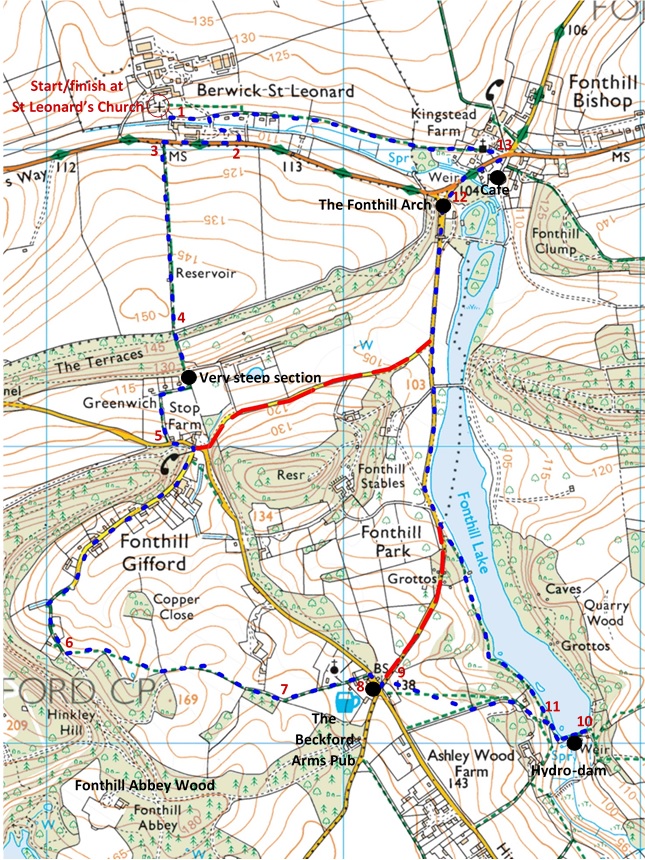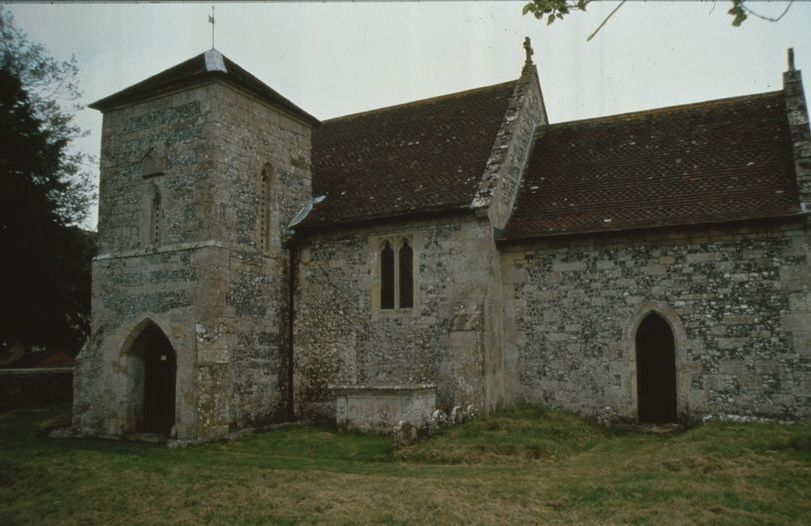Wiltshire: 5 mile walk from St Leonard’s Church, Berwick St Leonard
A beautiful countryside walk with lovely views of open fields, the Fonthill Lake and the magnificent Archway to the Fonthill Estate. Admire the pretty cottages in the villages of Fonthill Gifford and Fonthill Bishop, which have a pub and a café.
Please note some sections can be very muddy in winter after wet weather, so wellies are advised! Some sections are on the road, but this is generally quiet and there is a grass verge on the righthand side. There is also one very steep section which can be avoided by reversing the route. After passing through Fonthill Gifford, turn right at the red telephone box and take the road on the left signposted to Fonthill Bishop (marked red on the map).

1. Starting at St Leonard’s Church, walk out of the churchyard and follow the road round to the left. At the crossroads turn right into the business park. Turn left, following the road uphill to join the main road (B3089).
2. Turn right onto the narrow grass verge on the righthand side of the road and follow this for approx. 280 yards until you see a gap in the hedge on the left-hand side (shortly after passing Berwick House and the bus stop on the right). Cross the road and you’ll see a footpath sign on the telegraph pole. Before you reach the wide field gate there is a much narrower gate on the left hand side. Go through this small gate and turn right, following the footpath uphill, into the field.
3. Follow the footpath straight on through the field (pausing and looking back to see the view of St Leonard’s Church and surrounding countryside).
4. When you reach the band of trees at the end of the field, ignore the wider footpath which bears round to the left and the one which heads off to the right, but continue straight on downhill along the narrow footpath into the trees. After a short descent you’ll reach a junction of paths. Again, ignore the paths going off to the right and the one on the left marked private, but continue straight on down the very steep path (there is a handrail on the left, but please take care as the path is quite uneven and can be slippery when wet, you may find it easier to go down backwards). At the bottom follow the footpath round to the right (on the edge of the gardens belonging to some pretty estate cottages). Walk past the cottages and follow the road round to the left up to the main road.
5. Turn left onto the road and after 100 yards turn right at the red telephone box and post box into Stop Street. Walk through the village of Fonthill Gifford with its pretty cottages, following the road all the way through the village continuing uphill until you reach the woods and follow the footpath sign pointing left into the field. The woods are privately owned and contain the ruins of Fonthill Abbey. Designed by James Wyatt, one of the most celebrated architects of the 18th century, Fonthill Abbey (built 1796-1813) was perhaps the first notable picturesque building of the Gothic Revival and was famous for its 278-foot-high octagonal tower which collapsed twice.
6. Follow the footpath bearing right diagonally across the field, heading to the corner of the wooded area to your right. Keep to the right-hand edge of the field, into the next field, again keeping to the right-hand edge (this is where it can be very muddy in the winter).
7. After passing some trees on the right, climb over the stile in the right-hand corner of the field and follow the footpath, heading towards the Parish Church of Holy Trinity at Fonthill Gifford. This Gothic Revival Church (built 1864-66) was designed by T.H. Wyatt (second cousin of James Wyatt). When you reach some cottages follow the path straight ahead down to the road.
8. Turn right onto the road, passing The Beckford Arms on your right. At the crossroads turn left and go through the gate on the right into the field. This can be muddy in the winter so you can follow the road for about 1 mile with Fonthill Lake to your right (alternative route marked in red on the map).
9. Follow the footpath diagonally through the field, heading for the far right-hand corner. Follow the footpath downhill towards the lake. Pause on the bridge for a while to admire the view.
The lake was created in the mid-18th century for Alderman William Beckford, who bought the Fonthill estate in 1744 and built a grand Palladian mansion, Fonthill Splendens, between 1755 and 1770. Although, Fonthill Splendens was demolished in 1807 to make way for his sons, William Thomas Beckford’s Fonthill Abbey. The lake was used as a film location for the romance film Chocolat filmed in 2000, starring Johnny Depp. A hydro-dam was installed in 2011 which generates electricity for the estate with surplus sold back to the grid.
10. After admiring the lake, turn around and walk back the way you came, but go through the gate taking the lower path on the right, instead of the one uphill to the left which you just came down.
11. Follow the path with the lake on you right, passing a grotto on the left until you reach the layby where the footpath ends. Continue on the righthand side of the road heading towards the Fonthill Arch straight ahead. This grand classical archway was built in 1756 for Alderman William Beckford as the grand entrance to his estate and Fonthill Splendens.
12. Pass through The Fonthill Arch and follow the road to the right into the village of Fonthill Bishop. After passing the café and bus stop on the right, cross the road to the grassy area with a bench in the middle and follow the road to the left towards All Saint’s Church.
13. Enter the churchyard and follow the footpath through the churchyard and out into the fields beyond. Continue straight on through the fields until you reach Berwick St Leonard. Climb over the stile and follow the road straight on to return to St Leonard’s Church.

